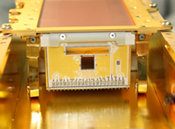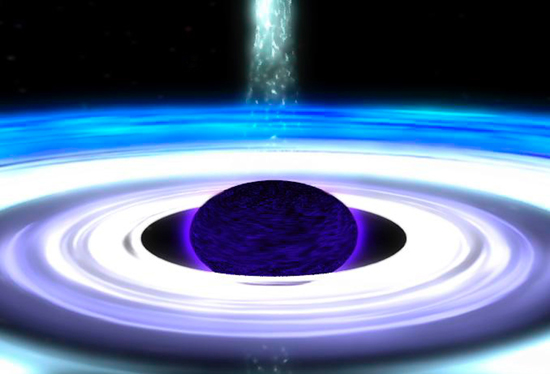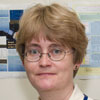Celebrating 50 Years of X-ray Astronomy:
The Future

The future of X-ray astronomy looks very promising, scientifically speaking. New technologies are being developed in order to glean as much information as possible from the X-ray light we can observe. One of these new tools is called polarimetry - by measuring the polarization of the X-ray light from as source, astronomers have another tool for studying the shape and environment of light-emitting regions.
Joe Hill works on polarimetry instrumentation at NASA's Goddard Space Flight Center.

"[In the next 10 years] I'm hoping we'll have polarimetry as just another tool in the toolbox, that is as commonly used as the spectrometer or as an imager. I'm hoping that's where we go."

Many of our scientists are looking ahead to the Astro-H project, an upcoming X-ray mission in the works by the Japanese with collaboration from NASA.

"[On Astro-H] there are two prime instruments: the X-ray calorimeter and the hard X-ray imager, and two subsidiary instruments: an X-ray CCD telescope camera, and a soft gamma-ray detector. The calorimeter is the one that Goddard is providing.
What's nifty about that is that in the X-ray band, we have suffered from not having good spectral resolution with enough collecting area. So, Chandra and XMM had breakthroughs in spectral resolution. The gratings were much, much better than anything that came before - 50 times better, but they need very long exposures and/or very bright sources.... The nice thing about the calorimeter is that it has much higher efficiency, so we have a lot more signal. It also has a very broad band pass. If you look at the way gratings work, they're sort of tuned - or blazed, it's called - to a particular wavelength. A calorimeter is a very broad band pass. What's most important is that gratings only work on things that are point-like. In a calorimeter, a photon lands on it, and you know its position, its time and its energy, so you can take a true spectral image. For extended sources, such as galaxies, supernova remnants and clusters, it's the first high-resolution spectrum."

"It's a spectroscopy question. Spectroscopy has been done before, but in a crude fashion. Astro-H increases the resolution of the spectroscopy by an order of magnitude. Gratings have a high resolution, but they have a low effective area. It can only look at one spectral line at a time. It's very time-consuming. Astro-H will allow you to see the entire spectrum at once. The resolution is commensurate with the resolution of gratings, and we will be able to see with high efficiency the entire spectrum at the same time. That's the first of a kind, and opens up all kinds of possibilities.
Koji Mukai is also looking forward to the Astro-H mission, and is excited about the progress being made there.

"We'll do some fantastic science of high-resolution spectroscopy in X-rays. Most of the instruments have the engineering models done, and they have been tested. Teams at Goddard and elsewhere have begun to build the full model instrument.... We are almost at the stage of starting full production of the instrument."

When asked what their vision of X-ray astronomy was for the next 50 years, these scientists were optimistic.

"It's amazing how much we have been able to do in 50 years. In terms of how good our instruments are today, I think we have made as much progress as optical astronomers did since the time of Galileo - the first optical telescope to the most powerful telescope today. I think we've come a long way, and I hope we can keep that up somehow."

"I hope we're on platforms with our detectors, and doing new things. We had talked about putting astronomy bases on the Moon. You can imagine going there and launching things from the Moon..., because you've got less gravity to overcome to get it out into space. You could take it out in pieces in a couple of SpaceX trips. Something more like the ISS, where you're doing your astrophysics from the space station, so you've got more people up there, and they can adjust what they do ... you can build stuff up a little bit."

"On the 100th anniversary, my hope is that we will be taking X-ray pictures of the event horizons of black holes. In ten years, my hope is that we will still be developing new X-ray missions in the U.S."

"A successor to Astro-H would be needed in order to provide comprehensive observations of astronomical sources together with the other next generation instruments. Especially it would enable us to continue determining the full accretion and feedback history of active galactic nuclei over time, i.e. the evolution of the universe.
On a time scale of 100 years, I think the best answer regarding the status of the field of X-ray astronomy has to be that we cannot envision it today. Turning the question around and thinking 100 years back, X-ray astronomy obviously did not even exist, and so fundamental astronomical concepts like the expansion of the universe or the processes inside stars were not yet known. One can speculate about observatories that might be possible, though, and ideas that have been mentioned are large X-ray telescopes in lunar craters or constructions that allow for milliarcsecond resolution X-ray interferometry. Furthermore, exciting synergies might be possible from simultaneous observations with neutrino or gravitational wave observatories."

"The legacy that I like to think of is that the Goddard group is important, not only in the U.S., but in the world, and being the second member to join this group, I feel that I was there right at the beginning of it. Within that time, and in that group, I pioneered two types of instruments [and was part of] several missions, including XTE, which was just decommissioned and produced a tremendous amount of data; the other was the mirrors, that are affordable, can fly in small spacecraft, and don't have to wait a lifetime before something like Chandra to fly again. They have taken over where the low-resolution proportional counters did, and continued with both timing and spectroscopy past that point."
Publication Date: June 2012


